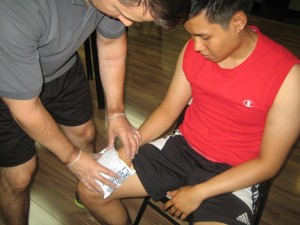Impetigo is a highly contagious infection of the skin that usually develops on the neck, face, arms and the legs. This condition can be caused by streptococcus pyogenes and staphylococcus aureus bacteria which infect the skin through a cut, injury or an insect bite or it can be injured due to some underlying conditions such as eczema or scabies.
Impetigo can affect anyone, but infants and children are more susceptible to this condition caused by factors such as a poor hygiene, attending a day care, warm weather and suffering from other skin infections such as dermatitis, impaired immunity or diabetes.
Common symptoms
- A red sore that bursts easily
- A light-brown colored crust that develops after the sore has burst
- Presence of blisters that are filled with fluid
- Itchiness or rashes on the affected area
- Lymph nodes are swollen and presence of skin lesions
Treatment

- Make an antibiotic solution by mixing a tablespoon of white distilled vinegar with 2 cups of lukewarm water. Dip a cotton ball in the solution and use this in cleaning the affected area, pat the skin dry and apply an antibiotic ointment, then cover it using gauze to help minimize the spread of infection and make the affected area dry. Repeat this at least 2-3 times every day until the infection disappears.
- Avoid scrubbing the affected area when washing in order to avoid irritation on the skin.
- Use a warm compress on the affected area for a few minutes since it helps in eliminating bacteria that caused the infection. It also helps in drying the sores and lesions triggered by impetigo. Repeat this procedure several times every day. Another way is using a blow dryer on the affected area but keep the settings of the blow dryer to a minimum.
- Mix a few drops of grapefruit seed extract to 2 tablespoons of water and apply it on the affected area 2-3 times every day since it helps with the condition.
- Apply aloe vera gel on the affected skin at least several times every day for fast healing of the condition.
- Mix one tablespoon of apple cider vinegar with 4 cups of water. Use this solution in cleaning the areas as well as help in minimizing the itching.
- Drink plenty of fluids on the first day of infection in order to help in the fast healing of the condition.
- Eliminate tobacco, caffeine, alcohol and also fried and oily foods from the diet.
- Apply manuka honey on the affected area and leave it on for a few hours, then wash it off using lukewarm water. Repeat this procedure every day. Manuka honey has antibacterial and antiseptic and also healing properties that helps control the growth of the bacteria that caused the infection.
- Eat a healthy diet such as eating fresh fruits and vegetables that are rich in antioxidants that helps the body in fighting infections
